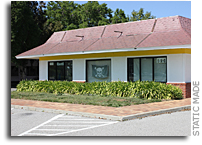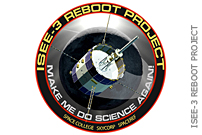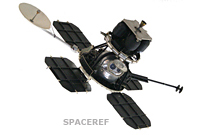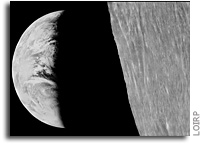 2-Minute Film Festival goes to the moon, Pittsburgh Post Gazette
2-Minute Film Festival goes to the moon, Pittsburgh Post Gazette
The lunar orbiter project is made up of “a group of dedicated space industry professionals who have worked for several years to digitally recover the first photographs of the moon and the first photographs of Earth taken from the moon,” Ms. Heffley said. Their work site is an abandoned McDonald’s on a NASA naval air station in Mountain View, Calif. When the Carnegie Museum film crew arrived in March, the team of techno-archaeologists had just digitized the final of the more than 1,400 magnetic tapes.
Extraterrestrial: The Lunar Orbiter Image Recovery Project and The 2-Minute Film Festival
Join us for the world premiere of Extraterrestrial, Part 3 of The Invisible Photograph. Begin the evening with a look into the Lunar Orbiter Image Recovery Project. See how a team of techno-archaeologists digitally recovered the first photographs of the moon, taken by unmanned space probes and used to determine the landing sites for the Apollo missions of the 1960s and the 1970s. Then join us in the Sculpture Court for a screening of finalists from this year’s 2-Minute Film Festival, showcasing films that explore the concept of outer space–in two minutes or less. Picnic food and bar open in the Sculpture Court beginning at 7:30 p.m.
The Invisible Photograph, a production of the Hillman Photography Initiative, is a five-part documentary series investigating the expansive realm of photographic production, distribution, and consumption by way of the hidden side of photography.
8:15-9 p.m.- Screening of Extraterrestrial with Keith Cowing, co-lead of the Lunar Orbiter Image Recovery Project and Divya Rao Heffley, Program Manager of the Hillman Photography Initiative.
9:15-11 p.m.- 2-Minute Film Festival, back for the 4th time!
$10; includes one drink ticket!
Culture Club is sponsored by: Great Lakes Brewing Company, Macy’s, and Bill Few Associates
LOIRP Imagery Featured in “Desert Moon”
Editor’s note: “Desert Moon”, by Jason Davis, premieres June 28, 2014 at the Flandrau Science Center and Planetarium in Tucson. The “Earthrise” imagery retrieved by the LOIRP is featured in the final film. We hope to have a link to an online version at some point soon.
Trailer Note:
In 1961, President John F. Kennedy boldly declared that Americans would walk on the moon before the end of the decade. But at the time, scientists weren’t even sure whether the moon’s surface was solid, or just a thick layer of dust.
At the University of Arizona, an astronomer named Gerard Kuiper established one of the world’s first laboratories dedicated solely to lunar and planetary science. His team built telescopes in the mountains above Tucson to create detailed photographic maps of the lunar surface that would help NASA land a man on the moon. Kuiper also became the principal scientist for the Ranger program, an effort to send America’s first spacecraft to the moon. Ranger spacecraft intentionally crash-landed on the lunar surface, sending back high-resolution photos during their approach.
Desert Moon follows the origins of the University of Arizona’s Lunar and Planetary Laboratory, and follows the effort to map and understand the moon prior to Neil Armstrong’s famous first step in 1969.
The documentary film features interviews with scientists who worked with Kuiper and helped kick-start the field of planetary science. Desert Moon debuts at Tucson’s Flandrau Science Center in Spring 2014.
Scott Manley Visits The Lunar Orbiter Image Recovery Project
McMoons, LOIRP, and ISEE-3 Make Front Page of the New York Times
 Calling Back a Zombie Ship From the Graveyard of Space, New York Times (front page story)
Calling Back a Zombie Ship From the Graveyard of Space, New York Times (front page story)
“For 17 years, [ISEE-3] has been drifting on a lonely course through space. Launched during the disco era and shuttered by NASA in 1997, the spacecraft is now returning to the civilization that abandoned it. It seemed destined to pass without fanfare, except for a slight chance of slamming into the moon, and then loop aimlessly through the inner solar system. But now, a shoestring group of civilians headquartered in a decommissioned McDonald’s have reached out and made contact with it — a long-distance handshake that was the first step toward snaring it back into Earth’s orbit. … Mr. Wingo and Keith Cowing, the editor of NASA Watch, a sometimes cantankerous website covering news and gossip about the space agency, had previously collaborated on a project that resurrected equipment to read 50-year-old magnetic tapes, extracting high-resolution images taken by NASA lunar orbiters in the 1960s — a task NASA had also regarded as infeasible. Mr. Wingo and Mr. Cowing decided ISEE-3 was another worthy effort.”
Carnegie Museum of Art LOIRP Documentary Premiere
.jpg)
2-Minute Film Festival, Carnegie Museum of Art
Join us under the stars as we reveal this year’s finalists-and give you the chance to vote for your favorite! Each year we pick a unique theme and ask filmmakers to submit their finest–and shortest–films to our 2-Minute Film Festival. To celebrate the interstellar premiere of Extraterrestrial: The Lunar Orbiter Image Recovery Project, part of the Hillman Photography Initiative’s Invisible Photograph documentary series, this year’s filmmakers explored the concept of outer space. With so much room for interpretation, we received a wide array of stellar entries from across the country and around the globe, and we can’t wait to share them with you!
Note: LOIRP Co-lead Keith Cowing will be a guest of the Carnegie Museum of Art as this film featuring the Lunar Orbiter Image Recovery Project is shown in public on 10 July 2014 for the first time.
Visiting McMoons and the Lunar Orbiter Image Recovery Project
 A Week With Techno-Archeologists, Static Made
A Week With Techno-Archeologists, Static Made
“I’ve spent the past week in Mountain View, California, hanging out with a group of Lunar Orbiter Image Recovery Project (LOIRP) hackers who are working out of an abandoned McDonald’s on the NASA Ames base. For more than five years, LOIRP technologists (or techno-archeologists, as they prefer to be called) have been reverse-engineering analog tape drives and developing new software in an attempt to unearth some of the first images of the moon that were taken by unmanned lunar orbiters in advance of the manned Apollo missions of the late 1960s. Upon entering the building (affectionately called “McMoon’s” by those who work within it) for the first time, I was greeted by familiar architecture. The drive-thru windows, menu light boxes, stainless steel counters, fiber glass tables and the ghosts of corporate brand ephemera all remain. However now they coexist under a jolly roger with a literal mountain of vintage 2-inch tape reels that contain trapped data, refrigerator-sized Ampex tape drives, an army of Mac workstations and a seemingly endless supply of analog tape decks, monitors, cables and soldering supplies.”
Images from the Carnegie Museum of Art team’s visit to McMoons last week on Flickr
ISEE-3 Reboot Project Is in Command of ISEE-3
 The ISEE-3 Reboot Project is pleased to announce that our team has established two-way communication with the ISEE-3 spacecraft and has begun commanding it to perform specific functions. Over the coming days and weeks our team will make an assessment of the spacecraft’s overall health and refine the techniques required to fire its engines and bring it back to an orbit near Earth.
The ISEE-3 Reboot Project is pleased to announce that our team has established two-way communication with the ISEE-3 spacecraft and has begun commanding it to perform specific functions. Over the coming days and weeks our team will make an assessment of the spacecraft’s overall health and refine the techniques required to fire its engines and bring it back to an orbit near Earth.
First Contact with ISEE-3 was achieved at the Arecibo Radio Observatory in Puerto Rico. We would not have been able to achieve this effort without the gracious assistance provided by the entire staff at Arecibo. In addition to the staff at Arecibo, our team included simultaneous listening and analysis support by AMSAT-DL at the Bochum Observatory in Germany, the Space Science Center at Morehead State University in Kentucky, and the SETI Institute’s Allen Telescope Array in California.
Of course this effort would not have been possible without the assistance of NASA and the Space Act Agreement crafted by NASA Headquarters, NASA Ames Research center, and the System Solar System Exploration Research Virtual Institute (SSERVI).
For further information on the ISEE-3 Reboot Project please visit our website at http://spacecollege.org/isee3 A much more detailed description of our First Contact efforts and future plans will be published on our website next week.
LOIRP In The News
 Engineers Are Rescuing Some of the First Photos Ever Taken from Lunar Orbit , Smithsonian
Engineers Are Rescuing Some of the First Photos Ever Taken from Lunar Orbit , Smithsonian
“The tapes that recorded the data beamed back to Earth, though, captured the photos in all their glory. Unfortunately, NASA held on to the tapes but tossed out the equipment used to read them. The efforts of the team behind the Lunar Orbiter Image Recovery Project, says Bierand, has so far given 2,000 old photos new life, including the Earthrise photo above, captured in 1966 and re-released a few years ago.”
LOIRP Team Announces the ISEE-3 Reboot Project
Our plan is simple: we intend to contact the ISEE-3 (International Sun-Earth Explorer) spacecraft, command it to fire its engines and enter an orbit near Earth, and then resume its original mission – a mission it began in 1978. ISEE-3 was rechristened as the International Comet Explorer (ICE). If we are successful it may also still be able to chase yet another comet.
Working in collaboration with NASA we have assembled a team of engineers, programmers, and scientists – and have a large radio telescope fully capable of contacting ISEE-3. If we are successful we intend to facilitate the sharing and interpretation of all of the new data ISEE-3 sends back via crowd sourcing.
NASA has told us officially that there is no funding available to support an ISEE-3 effort – nor is this work a formal priority for the agency right now. But NASA does feel that the data that ISEE-3 could generate would have real value and that a crowd funded effort such as ours has real value as an education and public outreach activity.
Time is short. And this project is not without significant risks. We need your financial help. ISEE-3 must be contacted in the next month or so and it must complete its orbit change maneuvers no later than mid-June 2014. There is excitement ahead as well: part of the maneuvers will include a flyby of the Moon at an altitude of less than 50 km.
Our team members at Morehead State University, working with AMSAT-DL in Germany, have already detected the carrier signals from both of ISEE-3’s transmitters. When the time comes, we will be using the large dish at Morehead State University to contact the spacecraft and give it commands.
In order to interact with the spacecraft we will need to locate the original commands and then develop a software recreation of the original hardware that was used to communicate with the spacecraft. These are our two greatest challenges.
The funding we seek will be used for things we have not already obtained from volunteers. We need to initiate a crash course effort to use ‘software radio’ to recreate virtual versions all of the original communications hardware that no longer physically exists. We also need to cover overhead involved in operating a large dish antenna, locating and analyzing old documentation, and possibly some travel.
This activity will be led by the same team that has successfully accomplished the Lunar Orbiter Image Recovery Project (LOIRP): SkyCorp and SpaceRef Interactive. Education and public outreach will be coordinated by the newly-formed non-profit organization Space College Foundation.
Our trajectory efforts will be coordinated by trajectory maestro Robert Farquhar and his team at KinetX. We are also working in collaboration with the Science Mission Directorate at NASA Headquarters, NASA Goddard Spaceflight Center, and the Solar System Exploration Research Virtual Institute (SSERVI) at NASA Ames Research Center.
Please consider making a donation to our project by visiting our RocketHub crowdfunding page.
For information contact Dennis Wingo at 310-403-1346 or by email at wingo -at- skycorpinc.com
LOIRP In The News
 McMoon’s revealed: Inside the hacker project that’s saving NASA’s lunar photos, Imaging Resource
McMoon’s revealed: Inside the hacker project that’s saving NASA’s lunar photos, Imaging Resource
“We’ve all been there: Media comes and goes, and despite your best efforts to keep your photo archives current, eventually you find a stray. Perhaps it’s an old Iomega Zip disk that got misplaced, or a floppy from your Sony Mavica that you found at the bottom of a drawer. Either way, you know there are photos on there, but you lack the hardware necessary to get at them. Your Zip drive long ago succumbed to the click of death, and seriously… when’s the last time you saw a computer with a floppy drive? It might surprise you, though, to learn that the same thing happened to photos shot by NASA while it was seeking out the best potential landing sites for the Apollo program.”
Lost 1960s moon photos recovered from analog tapes
“As the Beatles warmed up to play Shea Stadium for the second time, in August of 1966 a NASA satellite was quietly snapping images of the moon onto 70mm film and processing them in its robotic body before beaming the resulting images back to the Earth over analog radio waves.”
LOIRP Featured in ExtremeTech
 How hackers restored NASA’s lost lunar photos from inside an old McDonald’s, ExtremeTech
How hackers restored NASA’s lost lunar photos from inside an old McDonald’s, ExtremeTech
“The Lunar Recovery Project team has released new footage of restored lunar photos from NASA’s early probes and the difference in image quality between the old publicly released photos and the new material is simply stunning. The story of how the material was rescued is equally inspiring — the quest to preserve this material dates back to 1986, when JPL archivist Nancy Evans decided she could not, in good conscience, simply throw the old material away.”
LOIRP Featured by Wired Magazine
 The Hackers Who Recovered NASA’s Lost Lunar Photos, Wired
The Hackers Who Recovered NASA’s Lost Lunar Photos, Wired
“Sitting incongruously among the hangars and laboratories of NASA’s Ames Research Center in Silicon Valley is the squat facade of an old McDonald’s. You won’t get a burger there, though-its cash registers and soft-serve machines have given way to old tape drives and modern computers run by a rogue team of hacker engineers who’ve rechristened the place McMoon’s. These self-described techno-archaeologists have been on a mission to recover and digitize forgotten photos taken in the ’60s by a quintet of scuttled lunar satellites. The Lunar Orbiter Image Recovery Progject has since 2007 brought some 2,000 pictures back from 1,500 analog data tapes. They contain the first high-resolution photographs ever taken from behind the lunar horizon, including the first photo of an earthrise (first slide above). Thanks to the technical savvy and DIY engineering of the team at LOIRP, it’s being seen at a higher resolution than was ever previously possible.”
